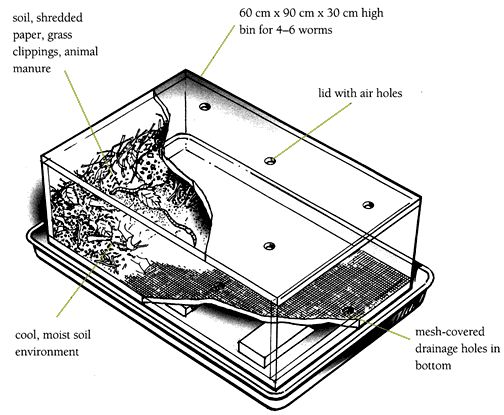You are here:
- Home »
- Teaching science »
- Caring for animals in the classroom »
- Worms (compost)
Worms (compost)
Housing
The bin
- Provide worms with a cool, damp soil environment that is similar to their natural home.
- A family of four to six worms needs a bin about 30 centimetres high, 60 centimetres wide, and 90 centimetres long. This will be big enough to eventually hold several thousand worms.
- Make sure that even though the bin's lid has air holes, it keeps out most of the light. Worms need air to breathe, but they are sensitive to light.
- The bin should also have holes in the bottom to let water drain away. Sit it on a tray to catch the water. The bottom of the bin should be covered with fine nylon mesh to stop the worms escaping through the drainage holes.
- Place the bin in a spot that has good air circulation.
- The ideal temperature range is 13–25°C. If the temperature rises to more than 29°C, the worms can die. They will also die if they are allowed to freeze.
The bedding
- Half-fill a bin with soil and shredded paper. Other materials, such as grass clippings, dried leaves, animal manure, and straw, are also suitable.
- Dampen the bedding because worms need to stay moist so that they can breathe. If the bedding is too dry or too wet, the worms will die.
Bin diagram
- temperature range 13–25°C
- feed once or twice a week
- finely chopped kitchen scraps
- give crushed eggshells at least once a week
- dull light.

Worms bin: main features
Bin diagram explanation
The bin shown measures 60cm x 90cm x 30cm high and is big enough for 4–6 worms.
The lid should keep out light and have air holes. The bin floor has mesh covered holes to let water drain away.
The floor should be a cool, moist soil environment consisting of soil, shredded paper, grass clippings, and animal manure.
Worms should be fed once or twice a week with finely chopped kitchen scraps and be given crushed eggshells at least once weekly.
Temperature range for worms 13–25°C.
How to care for worms
Feeding
- Feed worms once or twice a week.
- Make a shallow hole in the bedding and place finely chopped kitchen scraps in the hole. Worms cannot eat large chunks of food.
- Worms will eat any leftover food, but avoid meat, cheese, and other animal products because such food smells as it decays and can attract rats.
- Add crushed eggshells at least once a week because they contain nutrients that worms need.
- Cover the scraps with bedding and put them in a different place each time.
- Each day, one worm will eat about half the amount of its body weight.
Handling and health
- Monitor the temperature in the bin and the amount of food and water the worms have been given. Check that the bedding remains moist.
- Refresh the bedding several times a year. In two to three months, worms will eat through their bedding and build up a large number of castings. If the bin has too many castings in it, the worms will get sick.
- Before changing the bedding, you first need to remove the worms. To do this, dump the contents of the worm bin onto a large plastic sheet and sort it into little piles. Brush some of the soil off each pile. As they are exposed to the light, the worms will move to the centre of each pile, enabling you to pick them up and place them in a clean container. Do the same for each pile until all the soil has been removed.
- Refill the bin with fresh bedding and gently place the worms onto the surface. You can use the old soil as compost in the garden.
Copyright
The text and illustrations for this online edition of Caring for animals: A Guide for teachers, early childhood educators, and students (published on Te Kete Ipurangi for the New Zealand Ministry of Education in 2005) is copyright © Crown 2005. All rights reserved.
Content has been adapted for the web from the printed version, originally published in 1999 by Learning Media Limited for the Ministry of Education. Although no longer available this publication may still be available in some schools.

